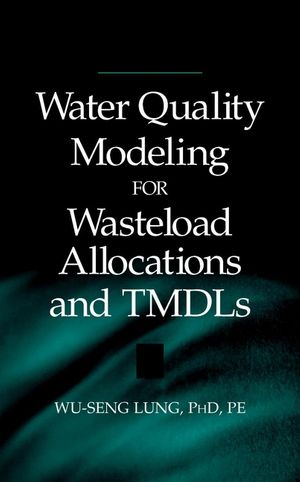Water Quality Modeling for Wasteload Allocations and TMDLsISBN: 978-0-471-15883-7
Hardcover
352 pages
April 2001
 This is a Print-on-Demand title. It will be printed specifically to fill your order. Please allow an additional 10-15 days delivery time. The book is not returnable.
|
||||||
Preface xi
Acknowledgments xv
1 Introduction 1
1.1 using a More Robust Model 2
1.2 Developing the Stream Reaeration Coefficient 4
1.3 Post Auditing the Water Quality Response – A Bigger Picture 4
1.4 New Horizon in Water Quality Modeling 6
1.5 It is the Modeling Skills and Data, Not the Model, That Matters 7
2 Total Maximum Daily Loads (TMDLs) 8
2.1 Evolution of Water Quality Modeling in Water Pollution Control 8
2.2 What Is a TMDL? 9
2.3 Water Quality Endpoints for TMDLs 11
2.4 Water Quality Modeling for TMDL 13
2.5 A TMDL Modeling Study 15
3 Derivation of Mass Transport Coefficients 21
3.1 One-Dimensional Advective Transport in Streams, Rivers, and Estuaries 22
3.2 One-Dimensional Longitudinal Dispersion Coefficient 30
3.3 Lateral Dispersion Coefficient in Rivers and Estuaries 34
3.4 Vertical Diffusion Coefficient 36
3.5 Two-Dimensional Vertically Integrated Mass Transport 43
3.6 Two-Dimensional Longitudinal/Vertical Mass Transport 44
3.7 Need a Hydrodynamic Model? 61
3.8 Linking a Hydrodynamic Model with a Water Quality Model 68
4 Derivation of Kinetic Coefficients 71
4.1 Biochemical Oxygen Demand and CBOD Ratio 72
4.2 Nitrification in Wastewater and Receiving Water 84
4.3 Reaeration Coefficient 89
4.4 Saturation Dissolved Oxygen Level 98
4.5 Sediment Oxygen Demand 99
4.6 Phytoplankton and Dissolved Oxygen 103
4.7 Dissolved Oxygen Impact 109
4.8 Phytoplankton/Nutrient Kinetics 110
4.9 Modeling Sediment Diagenesis Processes 119
4.10 Calibrating the Nutrient/Eutrophication Kinetics 124
4.11 Post Audit of BOD and Eutrophication Models 125
5 Computational Tools and Accessories 130
5.1 Computer Hardware and Capability 130
5.2 Modeling Frameworks and FORTRAN Compiler 132
5.3 Geographical Information System 133
5.4 Post Processing and Visualization 136
6 Using the Stream and QUAL2E Models 143
6.1 Equations Behind the Stream Model 144
6.2 Implementing the Governing Equation in STREAM Code 145
6.3 STREAM Model Input Structure 146
6.4 Application of STREAM to Rock Creek 149
6.5 Application of STREAM to the Roanoke River 158
6.6 Application of the QUAL2E Model to the Blackstone River 172
7 Using the WASP and Eutro Models 188
7.1 The WASP Model 188
7.2 Key Attributes 189
7.3 Mass Transport Modeling Applications 192
7.4 Water Quality Modeling Application 221
7.5 Numerical Tagging 241
7.6 Modeling Sediment-Water Interactions 252
7.7 Incorporating Nonpoint Source Loads 257
7.8 Linking a Hydrodynamic Model with the WASP/EUTRO model 261
7.9 Summary Remarks 268
8 Using the HAR03 Model 270
8.1 Model Capabilities 270
8.2 Input Data Structure and Model Configuration 271
8.3 Near-Field Mixing Zone Modeling 275
8.4 Modeling Mixing Zone in the James River Using HAR3 281
8.5 Far-Field Modeling 291
8.6 Summary 313
References and Further Readings 314
About the Author 325
Index 327



